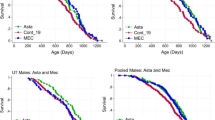Abstract
Recently, vinyl sulfones have been observed to selectively inhibit glyceraldehyde-3-phosphate dehydrogenase (GAPDH), which is an important ATP-generating enzyme in glycolysis. The possibility of using GAPDH as a biochemical parameter of cytotoxicity by vinyl sulfones was investigated using mouse lymphocytes. Incubation of lymphocyte GAPDH with ethylvinyl sulfone resulted in a pseudo-first-order loss of enzyme activity. The exposure of lymphocytes to ethylvinyl sulfone resulted in the decrease of GAPDH activity followed by ATP depletion and cell death, which were both dependent on the concentration of ethylvinyl sulfone. A further study on the time-dependent change indicated that cell death was preceded by ATP loss. Compared to ethylvinyl sulfone, divinyl sulfone was more than 8 times more potent in causing either ATP depletion or cell death.
Similar content being viewed by others
Abbreviations
- DTT:
-
dithiothreitol
- GAPDH:
-
glyceraldehyde-3-phosphate dehydrogenase
- NAD:
-
nicotinamide adenine dinucleotide
References
Andreoli SP. Mechanisms of endothelial cell ATP depletion after oxidant injury. Pediatr Res. 1989;25:97–101.
Bastyns K, Engelborghs Y. The interaction of acrylamide with glyceraldehyde-3-phosphate dehydrogenase. Structural modifications in the enzyme studies by fluorescence techniques. Photochem Photobiol. 1992;55:9–16.
Hartmann S, Neeff J, Heer V, Mecke D. Arenamycin: a specific inhibitor of glycolysis. FEBS Lett. 1978;93:339–42.
Hyslop PA, Hinshaw DB, Halsey WA Jr et al. Mechanisms of oxidant-mediated cell injury. J Biol Chem. 1989;263:1665–75.
Kitz RJ, Braswell LM, Ginsburg S. On the question: is acetylcholinesterase an allosteric protein. Mol Pharmacol. 1970;6:108–21.
Mol MAE, VanDe Ruit ABC, Kluivers AW. NAD levels and glucose uptake of cultured human epidermal cells exposed to sulfur mustard. Toxicol Appl Pharmacol. 1989;98:159–65.
Porath J, Laas T, Janson J-C. Agar derivatives for chromatography, electrophoresis and gel-bound enzymes. III. Rigid agarose gels cross-linked with divinyl sulfone. J Chromatogr. 1975;103:49–52.
Rosenberg Y, Lafrage-Frayssinet C. Inhibitory effect ofFusarium T2-toxin on lymphoid DNA and protein synthesis. Toxicol Appl Pharmacol. 1973;70:283–8.
Scheek RM, Slater EC. Glyceraldehyde-3-phosphate dehydrogenase from rabbit muscle. Methods Enzymol. 1982;89:305–9.
Sok D-E, Choi D-S, Kim Y-B, Lee Y-H, Cha S-H. Selective inactivation of glyceraldehyde-3-phosphate dehydrogenase by vinyl sulfones. Biochem Biophys Res Commun. 1993;195: 1224–9.
Wormser U. Toxicology of mustard gas. Trends Pharmacol Sci 1991;12:164–7.
Author information
Authors and Affiliations
Rights and permissions
About this article
Cite this article
Choi, D.S., Kim, Y.B., Lee, Y.H. et al. Glyceraldehyde-3-phosphate dehydrogenase as a biochemical marker of cytotoxicity by vinyl sulfones in cultured murine spleen lymphocytes. Cell Biol Toxicol 11, 23–28 (1995). https://doi.org/10.1007/BF00769989
Received:
Accepted:
Issue Date:
DOI: https://doi.org/10.1007/BF00769989




